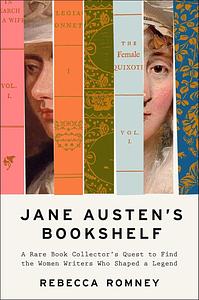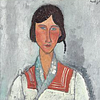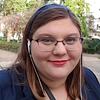Take a photo of a barcode or cover
informative
inspiring
reflective
medium-paced
An already too full to-read list just ballooned. All the women who inspired or simply were in conversation with Austen and her letters and books while she was living and thereafter. Romney spells out the mode of their erasure and how easily it is done depending on whose voice the critiquing is done in — or how well they did their homework! Also fascinating about the feminist recovery tradition.
informative
inspiring
Obsessed with this book. Yes, if you love Jane Austen, you will, naturally, love this book— it dives into the stories and authors that shaped her writing. But this book is more than that; it’s a revival and celebration of women’s histories. Romney adds to her predecessors’ work by helping to vindicate the great women authors that canon forgot.
While I was very interested in the subject matter, unfortunately I didn't find the writing to be the best. Plus, while I loved the historical side, I didn't find the insertions about the rare book trade captivating. On the other hand, this book allowed me to add many novels to my classics tbr, which is always good.
informative
inspiring
medium-paced
hopeful
informative
inspiring
reflective
relaxing
medium-paced
It was unsettling to realize I had read so many of the men on Austen’s bookshelf, but none of the women. from Jane Austen’s Bookshelf by Rebecca Romney
Back in 1978 I was in a two-semester honors class on Jane Austen. We read all of Austen’s novels the first semester, and her juvenilia, letters, and influencers the second. Prof. Toby Olshin allowed me to audit the second semester as I had already graduated. It was the most important and formative experiences in my education.
But that was a very long time ago and I am fuzzy about details. I know we read Ann Radcliffe’s The Mysteries of Udolpho in that class, which Romney notes as “one of the best reading experiences I’ve had,” and lists Samuel Johnson and Samuel Richardson as fans of the novel.
But I believe I read Richardson’s Pamela and Burney’s Evelina in another class on the early novel (which also included the Gothic classics Walpole’s The Castle of Otranto and Lewis’s The Monk.) Earlier in my college career, in a required survey course, I fell in love with the early novel. We read Henry Fielding’s Jonathan Wild and on my own delved into his other novels and books about the early novel.
I was excited to revisit this aspect of Austen’s writing life, and Jane Austen’s Bookshelf did not disappoint.
This is the story of how I collected books by, and books about, eight women writers whose works Jane Austen read, but who no longer have the widespread readership they once enjoyed. from Jane Austen’s Bookshelf by Rebecca Romney
The authors in the book include Frances Burney, Ann Radcliffe, Charlotte Lennox, Hannah More, Charlotte Smith, Elizabeth Inchbald, Hester Lynch Thrale Piozzi, and Maria Edgeworth.
Just reading their life stories is a treat. Several of these women wrote because they needed to support themselves. They had bad marriages. They lost children. They moved in the highest social circles and knew prominent literary men. At the time, the novel was not considered high art or appropriate reading for ladies. They were constrained in their careers and writing because of social and ethical pressures, needing to “justify their art” as moral influences.
Ann Radcliffe’s romances (a fantasy, or imagined story) influenced Walter Scott, Mary Shelley, Emily Bronte, Nathaniel Hawthorne, and Poe. And, Doyle’s The Hound of Baskerville and Stevenson’s Jekyll and Hyde and even Dickens’ A Christmas Carol. So, why didn’t I read her in my early novel course?
Partly because, like the other women in this book, she fell out of sight when Austen’s star rose, outshining them. No other writer had captured the lives of ordinary women as well as Austen. And because the canon was focused on male writers. I read Richardson, and Fielding, and Johnson in the early novel class. We even read The Pilgrim’s Progress and Robinson Crusoe and Gulliver’s Travels. But Burney was the only woman.
Romney discovered their work was delightful, witty, incisive, enjoyable. And the social and women’s issues they probe continue to be relevant.
This is not an academic (think ‘dull’) read. It is a memoir about Romney’s discovering these writers, her reactions and insights, and, as a bookseller of rare books, the quest to find early editions of their work. I found it a delightful read.
Thanks to the publisher for a free book through NetGalley.
Back in 1978 I was in a two-semester honors class on Jane Austen. We read all of Austen’s novels the first semester, and her juvenilia, letters, and influencers the second. Prof. Toby Olshin allowed me to audit the second semester as I had already graduated. It was the most important and formative experiences in my education.
But that was a very long time ago and I am fuzzy about details. I know we read Ann Radcliffe’s The Mysteries of Udolpho in that class, which Romney notes as “one of the best reading experiences I’ve had,” and lists Samuel Johnson and Samuel Richardson as fans of the novel.
But I believe I read Richardson’s Pamela and Burney’s Evelina in another class on the early novel (which also included the Gothic classics Walpole’s The Castle of Otranto and Lewis’s The Monk.) Earlier in my college career, in a required survey course, I fell in love with the early novel. We read Henry Fielding’s Jonathan Wild and on my own delved into his other novels and books about the early novel.
I was excited to revisit this aspect of Austen’s writing life, and Jane Austen’s Bookshelf did not disappoint.
This is the story of how I collected books by, and books about, eight women writers whose works Jane Austen read, but who no longer have the widespread readership they once enjoyed. from Jane Austen’s Bookshelf by Rebecca Romney
The authors in the book include Frances Burney, Ann Radcliffe, Charlotte Lennox, Hannah More, Charlotte Smith, Elizabeth Inchbald, Hester Lynch Thrale Piozzi, and Maria Edgeworth.
Just reading their life stories is a treat. Several of these women wrote because they needed to support themselves. They had bad marriages. They lost children. They moved in the highest social circles and knew prominent literary men. At the time, the novel was not considered high art or appropriate reading for ladies. They were constrained in their careers and writing because of social and ethical pressures, needing to “justify their art” as moral influences.
Ann Radcliffe’s romances (a fantasy, or imagined story) influenced Walter Scott, Mary Shelley, Emily Bronte, Nathaniel Hawthorne, and Poe. And, Doyle’s The Hound of Baskerville and Stevenson’s Jekyll and Hyde and even Dickens’ A Christmas Carol. So, why didn’t I read her in my early novel course?
Partly because, like the other women in this book, she fell out of sight when Austen’s star rose, outshining them. No other writer had captured the lives of ordinary women as well as Austen. And because the canon was focused on male writers. I read Richardson, and Fielding, and Johnson in the early novel class. We even read The Pilgrim’s Progress and Robinson Crusoe and Gulliver’s Travels. But Burney was the only woman.
Romney discovered their work was delightful, witty, incisive, enjoyable. And the social and women’s issues they probe continue to be relevant.
This is not an academic (think ‘dull’) read. It is a memoir about Romney’s discovering these writers, her reactions and insights, and, as a bookseller of rare books, the quest to find early editions of their work. I found it a delightful read.
Thanks to the publisher for a free book through NetGalley.
emotional
informative
inspiring
medium-paced
informative
slow-paced
informative
inspiring
reflective
slow-paced
informative
reflective
slow-paced





